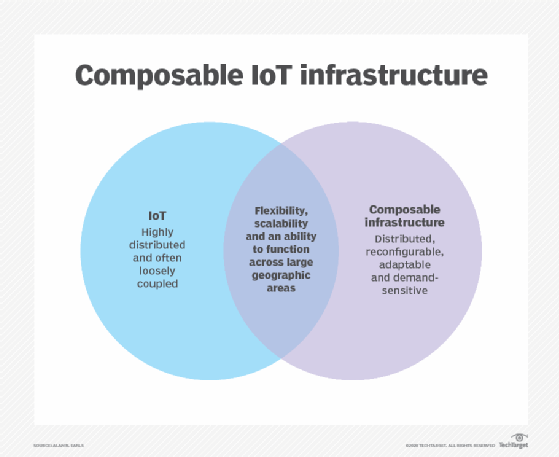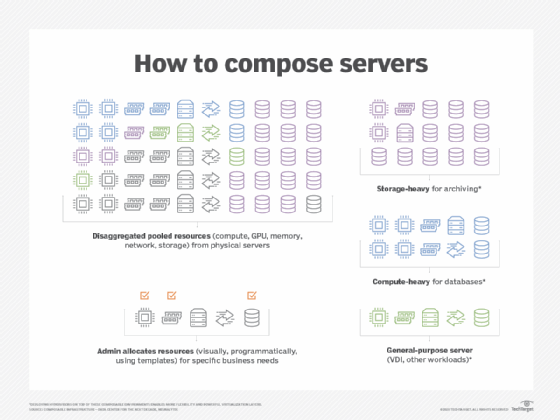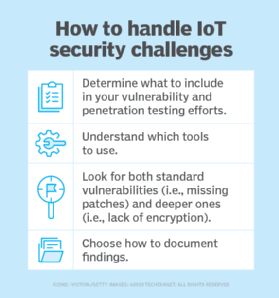
carloscastilla - Fotolia
Composable, an IoT infrastructure paradigm with potential
Composable infrastructure can stand up and down virtual servers depending on the varying needs of workloads. Learn why composability is a good for IoT.
The internet of things requires flexibility, scalability, functionality across large geographic areas, and increasingly, an ability to sustain extensive computing and data exchange across an entire system of systems. All these needs often exceed what a traditionally structured data center can deliver, spawning a growing drive toward distributed, edge computing. But edge alone isn't always ideal, especially when IoT's requirements shift. Edge can't always accommodate those changes as an IoT infrastructure.
The composable disaggregated infrastructure model may be just what an edge-oriented IoT infrastructure needs. Composability can -- by its very nature -- possibly ease the deployment and management of the separate workload-specific environments typical of the internet of things.
Without having to move and reconfigure physical assets, composable infrastructure systems are created dynamically and reconfigured as needed. Enterprises can readily configure those resources on demand to meet the IoT-driven needs as they develop.
How composability benefits IoT workloads
"The term IoT covers a wide variety of technologies, solutions and needs, so I am skeptical that any one technology can address all the needs of IoT," said Scott Sinclair, an analyst at Enterprise Strategy Group. That being said, there are multiple environments that fall under the IoT umbrella that would reap the benefits of composable infrastructure, he noted.
A common thread is that these IoT solutions are located outside the data center. This physical separation makes it more difficult to manage, tweak or optimize IoT infrastructure as demands change, he explained. The central idea behind composability is to allow the infrastructure to be composed or provisioned automatically via software rather than through manual intervention. "This capability is incredibility appealing when you are talking about IoT infrastructure, which can be dispersed over multiple distant locations," he said.
That need for scalability is a huge challenge for IoT, noted Michele Pelino, principal analyst at Forrester Research. "We aren't talking a few thousand endpoints, as you might with desktop or laptop computers. It could be millions or billions of endpoints," she said. That kind of scalability requirement has to be addressed in a different way from traditional IT; thus, making the characteristics of composability a potential fit. What's more, she noted, the environments in which IoT is deployed can vary geographically and in terms of physical surroundings, depending on the industry involved and the specific operational processes -- again, something not necessarily addressed with standard IT approaches.

"IoT is not yet stable. It is in a phase transition from liquid to solid, like warm Jell-O," said Christian Renaud, research vice president of the internet of things at S&P Global Inc. As a consequence, IoT implementers don't want to make big, expensive, fixed infrastructure decisions, "which could end up being like the embarrassing tattoo you got when you were 18," he said. And that reluctance to commit to a more traditional form of infrastructure is an opportunity for composable, he added.
Alfonso Velosa, an analyst at Gartner, said IoT also favors an event-based architecture where applications can be "shunted around" depending on lag, latency and the cost of sending data. That implies a distributed computer topology, but one that ensures sufficient resources wherever and whenever needed. At the moment, he added, containers in the cloud is a standard approach to delivering that distributed topology, but overall, "I am increasingly seeing people putting IoT software on the edge, in containers, typically either a Docker or Rancher approach," he said.
According to Velosa, the next step could be composable. "Vendors ranging from hyperscalers on down" are starting to look at composable disaggregated infrastructure relative to their IoT needs, he said.

Composable-IoT infrastructure: First steps
None of this sounds like a certain thing or a clear path for IoT or composable decision-makers -- at least, not yet. But that may not be a problem.
"While both IoT and composable infrastructure are still early in their maturity curves, I don't expect the same type of risk you might see with other new technologies," Sinclair said. That's because the underlying infrastructure technology is often based on existing, comprehensive, enterprise-level technology, he noted. What is new is the way it's managed.
"The risk with composability often results from a lack of insight on how to best manage, optimize or compose the infrastructure for the specific workload or application environment," Sinclair explained.

To this end, the vendors with composable offerings typically offer integrated intelligence or analytics features to help provide insight into the environment.
Another risk common with any remote technology is security. Therefore, any vendor with offerings for either IoT or composability needs to prioritize security functionality, as well, Sinclair said.
Where should one start a composable-IoT infrastructure journey? Sinclair said almost every infrastructure vendor is investigating how to improve automation and manageability, but "HPE and Liqid are two vendors that are actively driving the composability story."
However, "these solutions are rarely one size fits all. Approach IoT and composability with a plan and clear objectives -- the more narrowly focused, the better," Sinclair added. "Start small, then grow over time."







